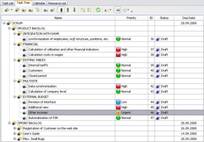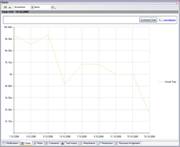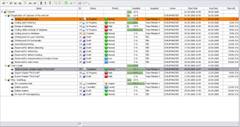 |
|
 |
VIP Task Manager |
 |
|
 |
VIP Task Manager |
|
Sprint In Scrum the iteration is called Sprint. Its duration takes one month (30 days). Outcome of Sprint is the finished product (build) which can be transferred (delivered) to the customer (at least, the system should be ready to be represented to the customer). Short sprints provide fast feedback from the customer to development team. The customer has an opportunity to operate the scope of the systems and after he estimates result of the sprint and offers improvements to the created functionality. Such improvements will be added in Product Backlog. Each sprint represents small "waterfall". During the sprint all works on gathering of requirements, design and coding of the product are being processed. | ||
|
Product Backlog Product Backlog is a prioritized list of business requirements and technical requirements available at present. Product Owner is responsible for Product Backlog. Product Backlog includes usages of cases, defects, enhancements, technologies, stories, features, issues, etc. At the beginning of the project Product Owner prepares Product Backlog, and the Scrum-team supplements this backlog with assessments of cost needed for realization of the requirements. The list should include functional and technical requirements needed for realization of the product. The most prioritized requirements should be described for their subsequent estimation and testing |
 |
|
|
Product Owner should take care of detailed requirements and provide with necessary volume in due time. In this sense programmers (Scrum-team) are requesters of requirements for Product Owner. In future the rest requirements should be specified and detailed gradually to the same level. The main idea is that the team always should have a sufficient volume of the requirements prepared for realization. To build up Product Backlog, Product Owner can create task group "Product Backlog" and split it to a number of sub-groups. In our example, the task group "Product Backlog" has five sub-groups: Integration with Into HR, Financial, Editing tables, Multi site and External budget. Each of these groups has tasks that can be created both by Product Owner and by Scrum-team. The team may need to add or specify some task groups and that's why Scrum-team can create new tasks. |
||
Spring Backlog After the planning session is over and Scrum-team has chosen and engaged itself to realize a group of requirements from Product Backlog, these requirements are broken into tasks that create a task list - Sprint Backlog. Breakdown on tasks should be made so that performance of one task takes no more than two days (it is considered that less detailed (for example, half-day) breakdown usually leads to a rough estimation). |
||
Breakdown on tasks will help to plan iteration in proper way and, as a result, there will be some outstanding tasks at the end of the process. After the end of detailed elaboration the estimation of Sprint Backlog is compared to a primary estimation in Product Backlog. If there is a considerable divergence, Scrum-team agrees with Product Owner about the volume of works that should be performed during iteration, and also about the volume to be shifted to the following one. Tasks that have less importance and influence on the iteration goal will be struck out from the Sprint Backlog. In VIP Task Manager you can create task groups and tasks. For example, we have three task groups: Registration of Customer on the web site, User's Guide, Mics. Small Bugs. Each of the group has tasks that are assigned to Scrum-team members by Scrum Master. He is owner (creator) of the tasks and he sets start dates and due dates for the tasks. Also VIP Task Manager allows to set task status, priority, progress, actual and estimated time for task accomplishment, time left, etc. | ||
Sprint Burn down Chart The sprint schedule (Burn down Chart) shows daily change of total volume of the works remained before the termination of the iteration. This schedule allows the team of developers to make the analysis of a current situation and react to deviations in due time. The sprint schedule also allows Product Owner to watch over the iteration. |
 |
|
|
If the total volume of works does not decrease every day, it means that something goes wrong. During the planning session the Scrum-team finds and estimates tasks which should be executed for successful end of the iteration. The estimation sum of all tasks of the Sprint Backlog is the total volume of work that should be accomplished for the iteration. Only in case the volume of works upon termination of the iteration has ended (there are no uncompleted tasks in sprint schedule) the iteration is considered successful. The sprint schedule is used as the secondary tool that allows to correct work for the finish of the iteration in time. VIP Task Manager allows to build graphic charts. Scrum Master can build chart that shows actual time spent on each task of the project. |
 Play Demo Play Demo
|
|
 |
|
 |
VIP Task Manager |



